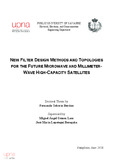Mostrar el registro sencillo del ítem
New filter design methods and topologies for the future microwave and millimeter-wave high-capacity satellites
| dc.contributor.advisor | Gómez Laso, Miguel Ángel | es_ES |
| dc.contributor.advisor | Lopetegui Beregaña, José María | es_ES |
| dc.creator | Teberio Berdún, Fernando | es_ES |
| dc.date.accessioned | 2019-03-06T12:40:45Z | |
| dc.date.available | 2020-09-21T23:00:10Z | |
| dc.date.issued | 2018 | |
| dc.date.submitted | 2018-09-21 | |
| dc.identifier.uri | https://hdl.handle.net/2454/32558 | |
| dc.description.abstract | In this thesis, several novel design techniques for waveguide low-pass filters (LPFs) and band-pass filters (BPFs) are proposed. Firstly, a quasi-analytical technique for classical corrugated waveguide LPFs is presented. It allows to reduce the design-times and its associated costs, since the final dimensions of the final prototype are computed by closed-form expressions. This technique has been extended to include the inherent rounded corners due to the fabrication by conventional milling techniques. In this case, the novel method is based on very simple equations which can be easily computed by an EM solver tool in a negligible CPU time. Additionally, a new method to embed routing capability in the classical corrugated LPF avoiding subsequent bending structures is also proposed. It permits to reduce the insertion loss, volume/weight, and PIM. The previous filters are the classical solution when the suppression of only the fundamental mode is needed. However, if the suppression of the higher-order modes is also a requirement, the classical solution is the waffle-iron filter. This filter has a cumbersome time-consuming design method mainly based on approximations and optimizations. In this Thesis, an accurate and simple design procedure for classical waffle-iron filters is also proposed. With this technique, waffle-iron filters with and without transmission zeros can be designed in a matter of minutes. Besides, a new type of waffle-iron filter is also presented. This novel structure is more compact and has lower insertion loss than its classical counterpart. The main issue of the previous classical filters is that it is not possible to achieve a wide rejected band and a high-power behavior simultaneously. This issue has been surpassed with the novel LPFs with smooth profile presented in this Thesis. Specifically, a synthesis technique has been developed, which permits to obtain larger gaps and very wide rejected bands at the same time. These new structures allow their use in high-power applications such as the output stage of satellite payloads. However, although their fabrication following space-compatible procedures has been demonstrated, it is quite difficult and expensive to be utilized in mass-production. Therefore, a new design method which accomplishes easy-to-manufacture LPFs with the same performance in terms of frequency and high-power behavior has been proposed. In this case, the objective is to reduce the fabrication costs and to develop a fully-customized technique that opens the range of potential applications of these devices. Indeed, its feasibility to be utilized as output filter in broadband satellite payloads, between the amplifiers and the diplexers in multi-beam payloads, and in high-performance diplexers is demonstrated. Furthermore, a combination between the latter low-pass filtering structure and a classical high-pass filtering function is utilized to develop a new class of BPF which can be used in high-performance compact satellite diplexers. Finally, a different BPFs with reduced sensitivity to manufacturing tolerances is also proposed. This structure finds its niche market in the upcoming Q/V-band satellite payloads. Indeed, the fabrication yield of a novel BPF intended for Q-band payloads has been dramatically improved in comparison with the one obtained from its classical counterpart. Last but not least, the size of the previous structures can be reduced with the new meandered topology developed in this Thesis. This technique permits to reduce the size of the previous BPFs (and also in classical LPFs) along with embedding routing capabilities, opening the door to more complex and compact terminals due to their adaptable and flexible layout. Additionally, it also allows to include several transmission zeros to enhance the out-of-band rejection of the LPFs. Low-power and high-power measurements have been performed in several manufactured prototypes to validate the frequency behaviour and the power-handling capability of the designed devices, respectively. | en |
| dc.format.extent | 338 p. | |
| dc.format.mimetype | application/pdf | en |
| dc.language.iso | eng | en |
| dc.subject | Filtros paso bajo | es_ES |
| dc.subject | Filtros paso banda | es_ES |
| dc.subject | Diseño | es_ES |
| dc.subject | Low-pass filters (LPFs) | en |
| dc.subject | Band-pass filters (BPFs) | en |
| dc.subject | Design | en |
| dc.title | New filter design methods and topologies for the future microwave and millimeter-wave high-capacity satellites | en |
| dc.type | info:eu-repo/semantics/doctoralThesis | en |
| dc.type | Tesis doctoral / Doktoretza tesia | es |
| dc.contributor.department | Ingeniería Eléctrica, Electrónica y de Comunicación | es_ES |
| dc.contributor.department | Ingeniaritza Elektrikoa, Elektronikoa eta Telekomunikazio Ingeniaritza | eu |
| dc.rights.accessRights | info:eu-repo/semantics/openAccess | en |
| dc.rights.accessRights | Acceso abierto / Sarbide irekia | es |
| dc.embargo.terms | 2020-09-21 | |
| dc.description.doctorateProgram | Programa de Doctorado en Tecnologías de las Comunicaciones, Bioingeniería y de las Energías Renovables (RD 99/2011) | es_ES |
| dc.description.doctorateProgram | Bioingeniaritzako eta Komunikazioen eta Energia Berriztagarrien Teknologietako Doktoretza Programa (ED 99/2011) | eu |


